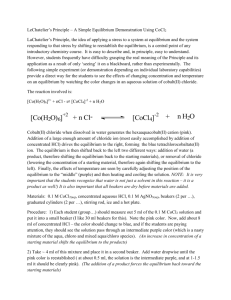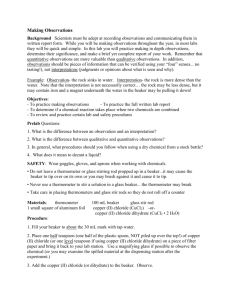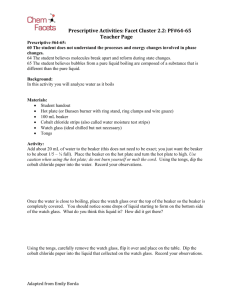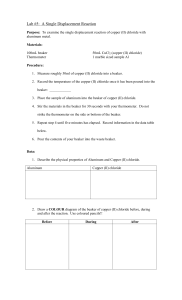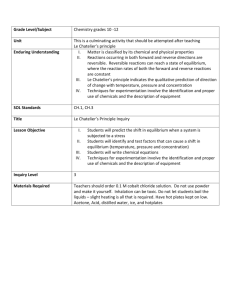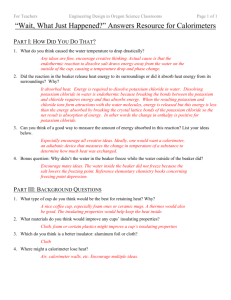Equilibrium - Le Chatelier`s Principle
advertisement
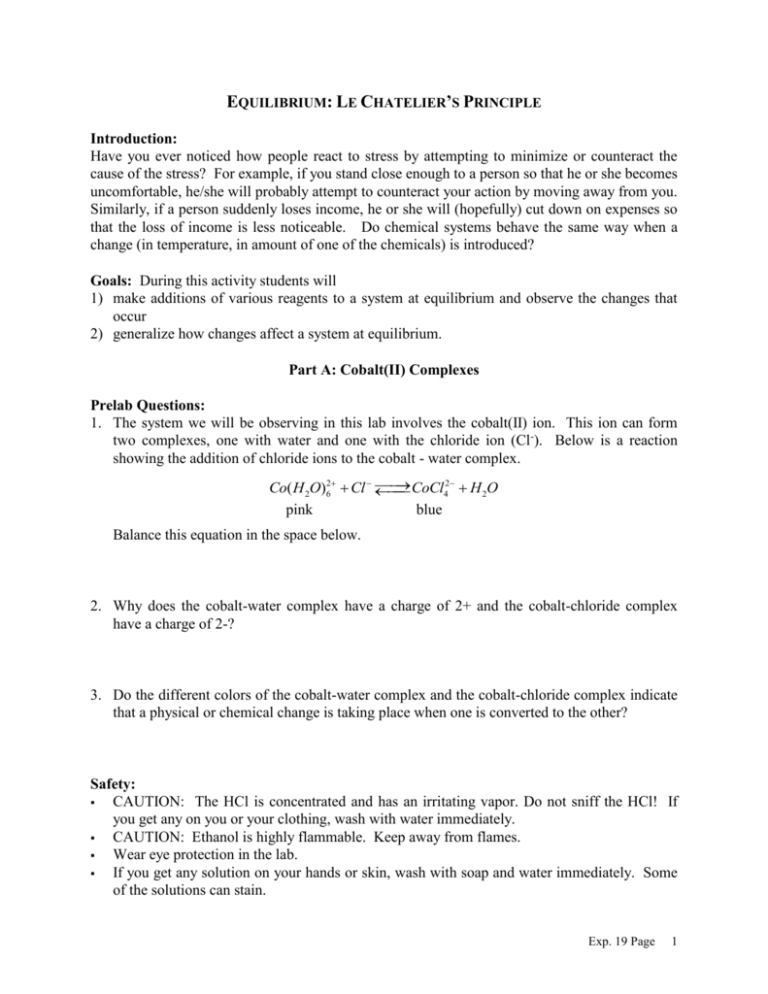
EQUILIBRIUM: LE CHATELIER’S PRINCIPLE Introduction: Have you ever noticed how people react to stress by attempting to minimize or counteract the cause of the stress? For example, if you stand close enough to a person so that he or she becomes uncomfortable, he/she will probably attempt to counteract your action by moving away from you. Similarly, if a person suddenly loses income, he or she will (hopefully) cut down on expenses so that the loss of income is less noticeable. Do chemical systems behave the same way when a change (in temperature, in amount of one of the chemicals) is introduced? Goals: During this activity students will 1) make additions of various reagents to a system at equilibrium and observe the changes that occur 2) generalize how changes affect a system at equilibrium. Part A: Cobalt(II) Complexes Prelab Questions: 1. The system we will be observing in this lab involves the cobalt(II) ion. This ion can form two complexes, one with water and one with the chloride ion (Cl-). Below is a reaction showing the addition of chloride ions to the cobalt - water complex. CoCl42 H 2O Co( H 2O)62 Cl pink blue Balance this equation in the space below. 2. Why does the cobalt-water complex have a charge of 2+ and the cobalt-chloride complex have a charge of 2-? 3. Do the different colors of the cobalt-water complex and the cobalt-chloride complex indicate that a physical or chemical change is taking place when one is converted to the other? Safety: CAUTION: The HCl is concentrated and has an irritating vapor. Do not sniff the HCl! If you get any on you or your clothing, wash with water immediately. CAUTION: Ethanol is highly flammable. Keep away from flames. Wear eye protection in the lab. If you get any solution on your hands or skin, wash with soap and water immediately. Some of the solutions can stain. Exp. 19 Page 1 Procedure and Observations: 1. Mass approximately 0.4 g of CoCl2 into the 50 mL beaker. 2. Add approximately 20 mL ethanol to the beaker. 3. Use the magnetic stirrer to mix the solution until all the CoCl2 is dissolved. DO NOT SET THE STIRRER ABOVE 3. What color is the solid cobalt(II) chloride? What color is the solution that forms? 4. Following the marking on the plastic pipet, add 1.5 mL of CoCl2 to each of 6 wells (1 row). Leave the remaining 10 mL of solution in the beaker to use later. The first and sixth wells are used as "controls". You will perform four different experiments in the middle wells. 5. Leave the first well as your "blue" control. 6. To the sixth well, add water dropwise with stirring until the solution becomes pale purple. What do you expect to happen if you added even more water? 7. Continue adding water dropwise with stirring to the sixth well until the color doesn't change with the addition of more water. Note the color below for reference. Final Color of Solutions: 8. Counting the drops, add a few drops of deionized water to the 2nd well until the color is the pale purple color, halfway between that of wells 1 and 6. Add the same number of drops to the 3rd, 4th, and 5th wells so wells 2-5 are all the same color. 9. To the 3rd well, add a few drops of 12 M hydrochloric acid. The instructor will have a small bottle of this. What do you observe? 10. To the 4th well add several lumps of calcium chloride (CaCl2). What do you observe? 11. To the 5th well add several drops of 0.1 M silver nitrate (AgNO3). What do you observe? Exp. 19 Page 2 12. To the solution in the beaker, add just enough water to get the pale purple color halfway between the blue and pink. Place the beaker on a hot plate and warm until you see a change. DO NOT SET THE HOT PLATE ABOVE 3. What do you observe? 13. Now, put the beaker in an ice bath and observe the color change. What happens? 14. Using a pipet, transfer the solution from step 13 to the large test tube. Holding the test tube with the test tube holder, warm the solution in the hot water bath. After the color change is complete, immerse the lower half of the test tube in the ice water bath. What do you observe? 15. If you are NOT continuing to Part C, place all waste in the approved waste container and wash hands thoroughly with soap and water. Postlab Questions: 1. To organize your observations, fill out the chart below. Write down the color and the complex. The first one is done for you. Procedure Step 7 Well 6 Step 8 Well 2 Step 9 Well 3 Step 10 Well 4 Step 11 Well 5 Step 12 beaker Step 13 beaker What was changed? Added H2O Original color/complex Final color/complex blue (CoCl42-) lavender pink (Co(H2O)62+) Exp. 19 Page 3 2. In step 4, water was added. CoCl42 H 2O Co( H 2O)62 Cl pink blue a) Judging by the color change, was more of the cobalt-water complex or cobalt-chloride complex produced when the water was added? b) Would you describe this as a reaction “to the left” meaning that more reactants were produced, or a reaction “to the right” meaning that more products were produced? What is the evidence of this? 3 a) In step 9, hydrochloric acid was added. What are the two ions present in hydrochloric acid? b) Which of these two ions is a part of the reaction? c) Did the addition of this ion produce a shift or reaction “to the left” or “to the right”? 4. Repeat question 3 for the addition of calcium chloride. 5. In step 11, silver nitrate was added. Silver nitrate “removes” chloride ions from solution because the silver ion reacts with chloride ions to form a white solid as shown below. AgCl (solid ) Ag (aqueous) Cl (aqueous) How did this “shift” the equilibrium? Exp. 19 Page 4 6 a) In step 12, heat was added. equilibrium? Judging by the color change, how did this affect the b) In step 13, heat was removed. Judging by the color change, how did this affect the equilibrium? 7. Looking back over the results, generalize the direction of the equilibrium for the following cases. a) reactant added b) product added c) reactant removed d) product removed 8 a) In other words, if we add extra reactant or product the system will attempt to do what? b) If we remove a reactant or product, what will the system will attempt to do? 9. Judging from your observations, is the reaction endothermic (requires heat as a reactant) or exothermic (releases heat as a product)? _________________ Why? Support your answer. Exp. 19 Page 5
